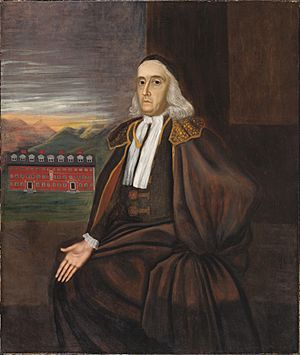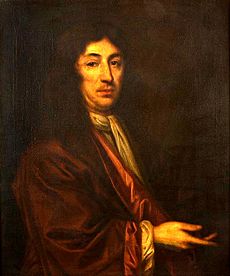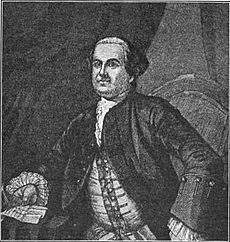William Stoughton (judge) facts for kids
Quick facts for kids
William Stoughton
|
|
|---|---|

Portrait by an unknown artist, c. 1700
|
|
| Acting Governor of the Province of Massachusetts Bay | |
| In office December 4, 1694 – May 26, 1699 |
|
| Preceded by | Sir William Phips |
| Succeeded by | Earl of Bellomont |
| In office July 22, 1700 – July 7, 1701 |
|
| Preceded by | Earl of Bellomont |
| Succeeded by | Massachusetts Governor's Council (acting) |
| Personal details | |
| Born | 1631 Kingdom of England or Massachusetts Bay Colony (accounts differ) |
| Died | July 7, 1701 (aged 69–70) Dorchester, Suffolk County, Province of Massachusetts Bay |
| Signature | |
William Stoughton (born 1631 – died July 7, 1701) was an important leader in the early Province of Massachusetts Bay. He was a Puritan judge and administrator. Stoughton is best known for his role in the Salem Witch Trials.
He served as the Chief Justice during these trials in 1692 and 1693. He allowed "spectral evidence" to be used. This meant believing that visions of evil spirits could prove someone was a witch. Unlike other judges, he never said he was wrong about this.
After studying at Harvard College in 1650, he continued his religious studies in England. He returned to Massachusetts in 1662 and chose a career in politics. He held many government positions. He was also the lieutenant governor of the province from 1692 until his death. He acted as governor for about six years. The town of Stoughton, Massachusetts is named after him.
Contents
Early Life and Education
William Stoughton was born in 1631. We don't know exactly where he was born. It was either in England or the Massachusetts Bay Colony. His parents, Israel and Elizabeth Stoughton, settled in Dorchester, Massachusetts, by 1632.
Stoughton went to Harvard College and graduated in 1650. He studied theology, which is the study of religion. He planned to become a Puritan minister. He then traveled to England to continue his studies at New College, Oxford. He earned his master's degree in theology in 1653.
Stoughton was a very religious preacher. He believed in God's promises for great things. At this time, England was under Puritan rule. Stoughton preached in Sussex. But when King Charles II returned to the throne in 1660, Stoughton lost his job. This happened because of new rules against certain religious groups.
Political Career and Land Deals
Since it was hard to find a new job in England, Stoughton came back to Massachusetts in 1662. He preached sometimes but decided not to become a full-time minister. Instead, he got involved in politics and buying land.
From 1671 to 1686, he served on the colony's council of assistants. This group helped the governor. He also represented Massachusetts in the New England Confederation. This was a group of colonies working together.

Stoughton was a close friend and business partner of Joseph Dudley. They worked together in politics and land development. In the 1680s, Stoughton bought a lot of land from the Nipmuc tribe. This land is now in Worcester County. They even helped set up the town of Oxford, Massachusetts, for French Huguenots who were seeking safety.
Stoughton and Dudley used their political power to make sure land titles were clear. This helped them and their friends. One official said it was hard to challenge their land claims in court. This was because the judges, like Stoughton and Dudley, were involved in the land deals themselves.
In 1686, Dudley was put in charge of the Dominion of New England. Stoughton was appointed to his council and became the deputy president. He also served as a judge and council member under Sir Edmund Andros. Stoughton was strict with leaders from Ipswich, Massachusetts. They had protested against taxes, saying it was unfair to be taxed without having a say in the government.
In 1689, Andros was arrested in a peaceful uprising. Stoughton supported this change. However, he was not very popular because of his past ties to Andros. He couldn't win elections. He then asked the powerful Mather family for help. In 1692, Increase Mather and Sir William Phips arrived from England. They brought a new charter for Massachusetts. They also brought a royal appointment for Phips as governor and for Stoughton as lieutenant governor.
Lieutenant Governor and Chief Justice
Role in the Witch Trials

When Governor Phips arrived, there were many rumors about witchcraft in Salem. Phips quickly put Stoughton in charge of a special court to handle these accusations. In June, Stoughton became the chief justice of the colonial courts. He held this job for the rest of his life.
During the famous Salem Witch Trials, Stoughton was both the main judge and the prosecutor. He was very strict with some of the accused. For example, he sent the jury back to rethink their "not guilty" decision for Rebecca Nurse. After this, she was found guilty.
Many people were convicted because Stoughton allowed "spectral evidence." This was the belief that a demon could only appear in the form of someone who had made a deal with the devil. Some judges had doubts about this type of evidence. But Stoughton was sure it was acceptable. He might have convinced other judges to agree. The special court stopped meeting in September 1692.
In late 1692, Governor Phips changed the colony's courts. The new courts, with Stoughton still as chief justice, heard the witchcraft cases in 1693. But Phips told them to ignore spectral evidence. Because of this, many cases were dismissed. Phips also canceled the few convictions that were made. On January 3, 1693, Stoughton ordered that all suspected witches who were pregnant should be executed. But Phips refused to allow this order. This made Stoughton angry, and he briefly left his position in protest.
Historians believe Stoughton accepted spectral evidence to try and strengthen Puritan authority. Unlike his fellow judge Samuel Sewall, Stoughton never said he regretted his actions in the trials.
Serving as Acting Governor
Stoughton also helped manage the colony's response to King William's War. This war started in 1689. Massachusetts Bay, which included parts of present-day Maine, was on the front lines against New France. French and Native American raids caused a lot of damage to northern towns.
Governor Phips often went to Maine to oversee defenses. This left Stoughton in charge of affairs in Boston. For example, Stoughton had to raise a small group of soldiers to help protect New Hampshire. In early 1694, Phips was called back to London. Stoughton became acting governor in November. Phips died in London in 1695.

Stoughton saw himself as a temporary leader. He waited for the King to appoint a new governor. He gave the local assembly a lot of freedom. This made it harder for future governors to control the assembly. He also did not do much to start new colonial policies. He only followed instructions from London when necessary. Someone in the colonial office said he was a "good scholar" but not good at enforcing trade laws.
In 1695, Stoughton complained about French privateers. These were private ships that attacked English fishing and merchant boats from Acadia. To fight back, he allowed Benjamin Church to plan a raid against Acadia. But before Church left, the French governor attacked an English fort in Maine. The fort was captured and destroyed. Church's mission did not achieve much. He only raided a small town before returning to Boston. Stoughton then sent another, smaller group, but they failed to capture a French fort. These failures showed that the colonial forces were not strong enough. Massachusetts asked London for help.
Peace between France and England came with the Treaty of Ryswick in 1697. But problems with the Abenaki people in the north continued. There were still arguments over fishing areas. Stoughton and the Acadian Governor exchanged complaints and threats in 1698. Stoughton asked London for diplomatic help, which eased some of the tension.
Stoughton was acting governor until 1699, while still serving as chief justice. He remained lieutenant governor when the Earl of Bellomont was governor. He became acting governor again in 1700 after Bellomont left. By then, Stoughton was in poor health. He did not achieve much in his final year.
Harvard College and the Brattle Street Church
The official status of Harvard College was uncertain after the colonial charter was canceled in 1684. Harvard's charter depended on it. In 1692, the assembly passed a new charter for the college. But the Board of Trade in England rejected it in 1696. This again put Harvard's future at risk.
Stoughton, as acting governor, made temporary plans for Harvard's management. The assembly worked on a new charter. Harvard's charter problems were finally solved in 1707.
There were also religious and political disagreements among Harvard's leaders in the late 1690s. Increase Mather, Harvard's president, was very traditional in his religious views. But other leaders had more moderate ideas. This led to a struggle for control of the college. This disagreement eventually led to the creation of Boston's Brattle Street Church in 1698. This new church openly disagreed with some of the stricter Puritan practices supported by Mather and his son, Cotton. Stoughton and other important religious and political figures helped solve the dispute. They did such a good job that Mather himself took part in the new church's opening services.
Family and Legacy
William Stoughton was given the Green Dragon Tavern around 1676. This was a sign of his high social status. It was an important building in Boston.
He died at his home in Dorchester in 1701 while still acting as governor. He was buried in the Dorchester North Burying Ground. Stoughton never married. He left his house and part of his money to William Tailer. Tailer was his nephew, the son of his sister Rebeccah. Tailer later became lieutenant governor twice and acting governor briefly. He was buried next to his uncle Stoughton.
Only one of Stoughton's sermons was published. It was called New-Englands True Interest. He first gave this sermon in 1668, and it was published in 1670. In it, he talked about the colony's beginnings. He said, "God sifted a whole Nation that he might send choice Grain over into this Wilderness." But he also felt that Massachusetts society was declining. He urged people to trust the judgment of their religious leaders.
The town of Stoughton, Massachusetts is named after him. Also, one of the dorms at Harvard College in Harvard Yard is named in his honor. Stoughton gave £1,000 to help build the first Stoughton Hall in 1698.
Images for kids


